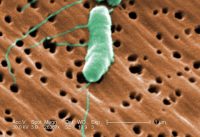
Following reports of three deaths due to Vibrio infections in the state last month, health officials remind those with wounds or cuts exposed to warm saltwater or brackish waters that they could come in contact with these bacteria.
Found naturally in warm waters worldwide, people with open wounds, cuts or scratches can be exposed to Vibrio through direct contact with seawater or brackish water. Vibrio can also cause disease in those who eat raw or undercooked oysters and shellfish, North Carolina Department of Health and Human Services officials warn.
Supporter Spotlight
A department spokesperson reiterated Monday that it is important for folks to know that all warm brackish and salt water poses a risk of infection since the bacteria is naturally occurring in that environment. They added that everyone should take precautions if they are in these types of waters, especially if they have any type of wound, even minor, because they are at higher risk for severe illness if they were to contract Vibrio.
Though Vibrio cases in the state are rare, most are reported in the warmest months of June through September. Since 2019, eight of the 47 reported cases among North Carolina residents have been fatal, with the three most recent in July of this year, officials warn.
Two of the three cases had scratches that were exposed to brackish water in North Carolina and another east coast state. The third case also had brackish water exposure in North Carolina, but the individual also consumed personally caught seafood that was not shared nor commercially distributed.
No links have been identified between the cases or the areas where they were likely exposed to Vibrio, and public health investigations are ongoing. No other information about the decedents will be shared at this time due to privacy concerns, officials said in late July.
While healthy individuals typically develop mild illness, Vibrio infections can be severe or life threatening for people with weakened immune systems or chronic liver disease.
Reports of Vibrio infections associated with brackish water contact have been increasing over the past several decades, and the geographic range of waters associated with infection is spreading north along the East Coast due to increasing water temperatures. As climate change increases water temperatures, more Vibrio cases can be expected, and they are likely to be identified in previously unaffected areas, officials said.
Supporter Spotlight
If you start to see signs of a skin infection after contact with brackish waters or seawater, you should contact your health care provider. Other symptoms can include diarrhea, stomach pain, vomiting, nausea, fever and chills.
State officials suggest the following to help reduce exposure and infection:
- If you have a wound including from a recent surgery, piercing or tattoo, stay out of saltwater or brackish water, if possible. This includes wading at the beach.
- Cover your wound with a waterproof bandage if it could come into contact with saltwater, brackish water or raw or undercooked seafood.
- If you sustain any type of wound while in salt or brackish water such as cutting your hand on a boat propeller or crab pot, immediately get out of the water and wash with soap and water.
- Wash wounds and cuts thoroughly with soap and water after contact with saltwater, brackish water or raw seafood.
- Thoroughly cook all shellfish to an internal temperature of at least 145 degrees Fahrenheit for 15 seconds, according to the U.S. Department of Agriculture.
More information can be found on the Center for Disease Control and Prevention website or the NCDHHS vibrio infections webpage.








